clouds accumulate
range upon range beyond range
lift from the horizon
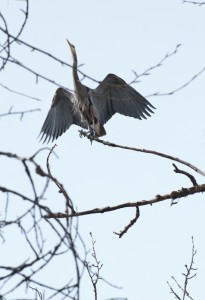 It was one of those mornings when my to-do list was weighing me down with its shoulds and have tos. I was overwhelmed by the shear number of them, making me snuggle deeper into the covers and feign sleep. But I could hear the clattering in the kitchen of my husband starting his day and I poked my head up to stare out the window into the backwoods . My planning for the day was suddenly interrupted by the pterodactyl form of a heron weaving its way through the sticky buds of the cottonwoods, then another and another until finally I had seen seven great blue herons making their way north, toward the hundred acre wood next door.
It was one of those mornings when my to-do list was weighing me down with its shoulds and have tos. I was overwhelmed by the shear number of them, making me snuggle deeper into the covers and feign sleep. But I could hear the clattering in the kitchen of my husband starting his day and I poked my head up to stare out the window into the backwoods . My planning for the day was suddenly interrupted by the pterodactyl form of a heron weaving its way through the sticky buds of the cottonwoods, then another and another until finally I had seen seven great blue herons making their way north, toward the hundred acre wood next door.
Instead of getting up and feeding the dog, emptying the dishwasher, checking my e-mail, I threw on some clothes, grabbed my camera and headed out the door in the direction the great birds flew. I waded through the tall frosty grass to the fence where the lace work of spider webs wove between the barbed wire. I passed the pond where a red tail hawk circled low over the water and looking up I saw in the distance a huge stick nest in a cottonwood tree. Climbing over the fence into the hundred acre wood I saw another nearby and then another.
Twenty one nests in all, 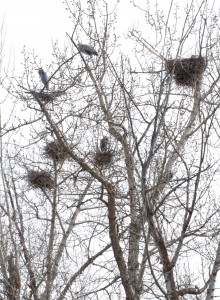 and a flurry of activity. Pairs of birds clustered around some of the nests, or one bird sat in the nest while another sat on the branch, standing guard. At one point a third heron approached a nest and was driven away with a great deal of the croaking squawk that sounds so incongruent from these elegant looking birds.
and a flurry of activity. Pairs of birds clustered around some of the nests, or one bird sat in the nest while another sat on the branch, standing guard. At one point a third heron approached a nest and was driven away with a great deal of the croaking squawk that sounds so incongruent from these elegant looking birds.
This lone heron then circled over another nest and the resident male stretched its neck out in the gesture that clearly meant come no closer.
Wandering around under the nests I came across a broken shell. The pale blue of a robin’s egg, it was the size of a large chicken egg. I looked above and saw a nest that was clearly in the early stages. The male heron flew in with a stick his mouth, offering it to the female who 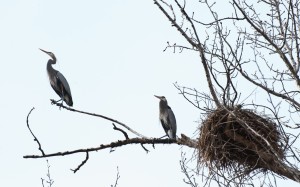 placed it carefully in the nest. I wondered if their nest had fallen and they had had to start over, but there was no sign of scattered sticks near the broken egg.
placed it carefully in the nest. I wondered if their nest had fallen and they had had to start over, but there was no sign of scattered sticks near the broken egg.
Higher up in the same tree another couple had apparently finished the work on their own nest.
After spending several hours watching the activity in the rookery, I reluctantly returned to my own nest to get to work on those chores.
I didn’t back out to the rookery until this week and by then the activity in the rookery had quieted down considerably. Peering into the nests though, you could just see the beaks of the brooding birds. The eggs take 28 days to hatch.
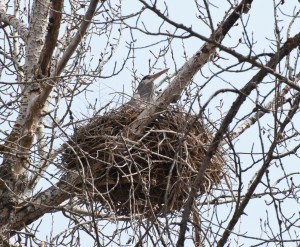 With a clutch of 6-8 eggs, only two or three will survive. And on the ground, near where I found the first broken shell, were two more. Was it predation by an eagle? A racoon? Or had the mother heron knocked the eggs from the nest when she turned them? Egg turning is a crucial process because the egg has to be kept evenly warm and the embryo on top, so the chick can develop fully in the shell.
With a clutch of 6-8 eggs, only two or three will survive. And on the ground, near where I found the first broken shell, were two more. Was it predation by an eagle? A racoon? Or had the mother heron knocked the eggs from the nest when she turned them? Egg turning is a crucial process because the egg has to be kept evenly warm and the embryo on top, so the chick can develop fully in the shell.
The cottonwoods are beginning to leaf out now which will make viewing the nests much more difficult. But I plan to keep track of the activity in the rookery and will be heading out for the next two and half months until the fledglings are ready to fly. Just another thing to add to my to-do list.
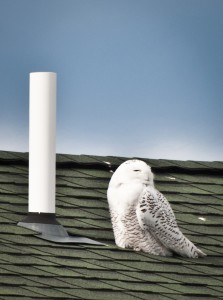 Spring is here. Last day of skiing–a season that started with a fizzle (lack of snow), ended with a drizzle (a downpour that washed out what little enthusiasm anyone had left for hitting the slopes). The trees are budding out and the buttercups are blooming in the backwoods.
Spring is here. Last day of skiing–a season that started with a fizzle (lack of snow), ended with a drizzle (a downpour that washed out what little enthusiasm anyone had left for hitting the slopes). The trees are budding out and the buttercups are blooming in the backwoods.
The irruption of snowy owls, who showed up last January in Polson for the first time in living memory, have headed back up to the Arctic. They caused quite a sensation while they were here though, with people carrying 3 foot camera lenses and giant spotting scopes invading the hilltop subdivision where the owls had taken up residence. Organized tours of bird enthusiasts came from as far away as Texas to gawk at the beautiful white owls sitting on asphalt shingled roofs.
I was one of the pilgrims who went to see the owls–and take the requisite pictures with my inadequate lens. But, unlike so many other birdwatchers, I came away feeling a little deflated. I have a friend who has spent years hiking and exploring in Alaska, always in hopes of seeing a snowy owl in the wild, with no success. And then he had to do nothing more than drive an hour north to Flathead Lake, look for the knot of cars and people on the water tower hill, and there they were. He didn’t even have to get out of his car.
I can understand my friend’s disappointment. I felt it too, though I hadn’t hiked hundreds of miles to see a snowy owl. Something was missing and it wasn’t just the incongruity of seeing those wild birds roosting near the white vent pipes in the subdivision. It had something to do with the thrill of discovery. The sense of wonder is muted when you don’t find something on your own, whether it’s a “wildlife viewing opportunity” like this or on a guided tour, nature show or in a zoo. It becomes somehow a second hand experience.
Discovering a bird in the wild, or maybe a snow leopard in the Himalayas as in Peter Mathiason’s book The Snow Leopard, is not about checking it off your life list or getting the picture. It’s about what you discover in yourself in the process. It’s about the search, and the feeling of awe when you make that discovery. To me, it’s like the difference between a flash of insight and connection when you’re writing and sitting down with a book, reading someone else’s wisdom.
Maybe that’s the reason a week later when visiting Yellowstone, I didn’t mind not making it out to the Lamar Valley to see the wolves. Mammoth was abuzz with the pack of wolves who were feeding on a bison carcass near the road and people were showing off their pictures. But I was afraid the experience would be like the snowy owls. Instead, I contented myself with savoring the sight of a merganser swallowing a giant (5″) silver fish whole. No one’s totem animal I know, but the sighting was mine and a thrill.
P.S. There was an article today in the Missoulian (Thursday, April 19) that said there are now a couple of different apps for your phone that will report wildlife sightings in Yellowstone. The only saving grace for such insanity is that cell phone coverage is spotty in Yellowstone.